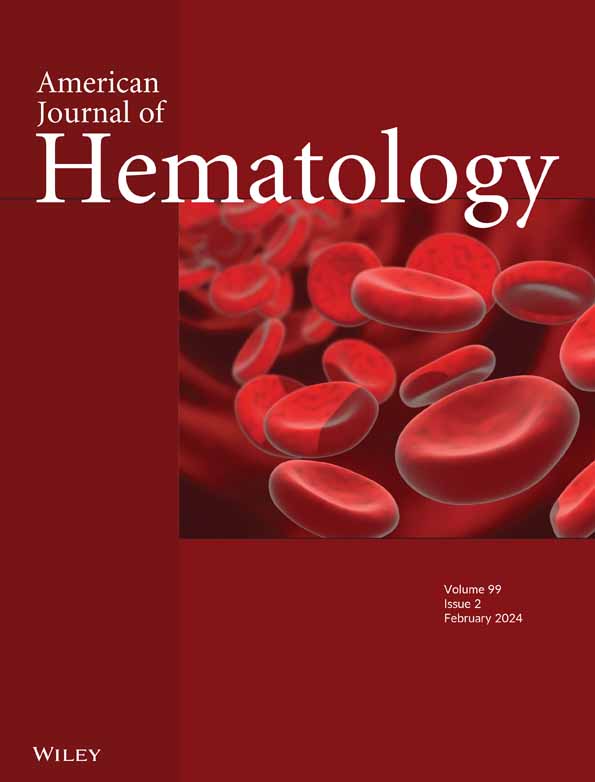Risk Factors for and Impact of Pre-Engraftment Syndrome on Outcomes Following Single-Unit Cord Blood Transplantation in Adults.
IF 9.9
1区 医学
Q1 HEMATOLOGY
引用次数: 0
Abstract
Pre-engraftment syndrome (PES) is a unique complication of cord blood transplantation (CBT) whose risk factors and impact on transplant outcomes remain controversial. Using a nationwide database in Japan, we analyzed a total of 3734 patients who underwent single-unit CBT. PES occurred in 18.3% of patients, and risk factors for PES included a higher hematopoietic cell transplantation-specific comorbidity index, first transplantation, myeloablative conditioning (MAC), lower total nucleated cell (TNC) dose, and graft-versus-host disease (GVHD) prophylaxis regimens excluding tacrolimus with methotrexate. Patients who developed PES had significantly higher incidences of grade II-IV acute GVHD (53.1% vs. 31.3%, p < 0.001) and chronic GVHD (27.2% vs. 21.7%, p = 0.002) compared to those without PES. Landmark analysis with multivariable adjustment revealed that PES was independently associated with increased non-relapse mortality (NRM, hazard ratio [HR] 1.46; 95% CI 1.22-1.75; p < 0.001), reduced relapse incidence (HR 0.78; 95% CI 0.63-0.96; p = 0.020), and a trend toward inferior overall survival (OS, HR 1.13; 95% CI 0.98-1.30; p = 0.088). Moreover, patients who experienced both PES and acute GVHD had the highest 2-year NRM (31.7%; 95% CI 26.0%-37.6%) and the lowest 2-year OS (55.9%; 95% CI 50.0%-62.4%), compared with those who experienced either PES (NRM 20.7%; OS 65.0%) or acute GVHD (NRM 19.5%; OS 62.8%) (p < 0.001), highlighting the combined effects of these complications. This study, the largest to date on PES, demonstrates its clinical significance as an early complication with lasting effects on transplant outcomes.成人单单位脐带血移植后移植前综合征的危险因素及影响。
移植前综合征(PES)是脐带血移植(CBT)中一种独特的并发症,其危险因素及其对移植结果的影响仍存在争议。使用日本全国数据库,我们分析了总共3734名接受单单位CBT治疗的患者。PES发生在18.3%的患者中,PES的危险因素包括较高的造血细胞移植特异性合并症指数、首次移植、清髓调节(MAC)、较低的总有核细胞(TNC)剂量,以及不包括他克莫司和甲氨蝶呤的移植物抗宿主病(GVHD)预防方案。与没有PES的患者相比,发生PES的患者II-IV级急性GVHD(53.1%比31.3%,p < 0.001)和慢性GVHD(27.2%比21.7%,p = 0.002)的发生率明显更高。多变量校正的里程碑分析显示,PES与非复发死亡率增加(NRM,危险比[HR] 1.46; 95% CI 1.22-1.75; p < 0.001)、复发率降低(HR 0.78; 95% CI 0.63-0.96; p = 0.020)和总生存期下降趋势(OS, HR 1.13; 95% CI 0.98-1.30; p = 0.088)独立相关。此外,与PES (NRM 20.7%, OS 65.0%)或急性GVHD (NRM 19.5%, OS 62.8%)患者相比,同时经历PES和急性GVHD的患者2年NRM最高(31.7%,95% CI 26.0%-37.6%), 2年OS最低(55.9%,95% CI 50.0%-62.4%) (p < 0.001),突出了这些并发症的综合影响。这项迄今为止最大的关于PES的研究,证明了其作为对移植结果有持久影响的早期并发症的临床意义。
本文章由计算机程序翻译,如有差异,请以英文原文为准。
求助全文
约1分钟内获得全文
求助全文
来源期刊
CiteScore
15.70
自引率
3.90%
发文量
363
审稿时长
3-6 weeks
期刊介绍:
The American Journal of Hematology offers extensive coverage of experimental and clinical aspects of blood diseases in humans and animal models. The journal publishes original contributions in both non-malignant and malignant hematological diseases, encompassing clinical and basic studies in areas such as hemostasis, thrombosis, immunology, blood banking, and stem cell biology. Clinical translational reports highlighting innovative therapeutic approaches for the diagnosis and treatment of hematological diseases are actively encouraged.The American Journal of Hematology features regular original laboratory and clinical research articles, brief research reports, critical reviews, images in hematology, as well as letters and correspondence.

 求助内容:
求助内容: 应助结果提醒方式:
应助结果提醒方式:


